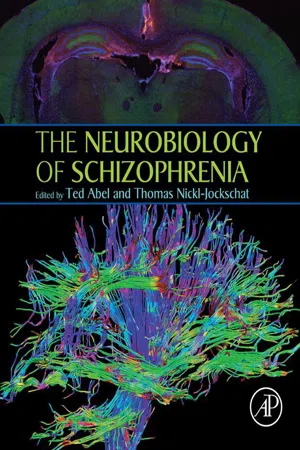
- 468 pages
- English
- ePUB (mobile friendly)
- Available on iOS & Android
The Neurobiology of Schizophrenia
About this book
The Neurobiology of Schizophrenia begins with an overview of the various facets and levels of schizophrenia pathophysiology, ranging systematically from its genetic basis over changes in neurochemistry and electrophysiology to a systemic neural circuits level. When possible, the editors point out connections between the various systems. The editors also depict methods and research strategies used in the respective field. The individual backgrounds of the two editors promote a synthesis between basic neuroscience and clinical relevance.- Provides a comprehensive overview of neurobiological aspects of schizophrenia- Discusses schizophrenia at behavioral, cognitive, clinical, electrophysiological, molecular, and genetic levels- Edited by a translational researcher and a psychiatrist to promote synthesis between basic neuroscience and clinical relevance- Elucidates connections between the various systems depicted, when possible
Frequently asked questions
- Essential is ideal for learners and professionals who enjoy exploring a wide range of subjects. Access the Essential Library with 800,000+ trusted titles and best-sellers across business, personal growth, and the humanities. Includes unlimited reading time and Standard Read Aloud voice.
- Complete: Perfect for advanced learners and researchers needing full, unrestricted access. Unlock 1.4M+ books across hundreds of subjects, including academic and specialized titles. The Complete Plan also includes advanced features like Premium Read Aloud and Research Assistant.
Please note we cannot support devices running on iOS 13 and Android 7 or earlier. Learn more about using the app.
Information
Historical and Clinical Overview
Implications for Schizophrenia Research
Abstract
Keywords
Introduction
| DSM-V | ICD-10 |
Two (or more) of the following, each present for a significant portion of time during a 1-month period (or less if successfully treated) At least one of these should include 1–3 | Either at least one of the syndromes, symptoms, and signs listed as 1–4 or at least two of the symptoms and signs listed as 5–8 should be present for most of the time during an episode of psychotic illness lasting for at least 1 month (or at some time during most of the days). |
1. Delusions | 1. Thought echo, thought insertion or withdrawal, or thought broadcasting |
2. Hallucinations | 2. Delusions of control, influence, or passivity, clearly referred to body or limb movements or specific thoughts, actions, or sensations; delusional perception |
3. Disorganized speech | 3. Hallucinatory voices giving a running commentary on the patient’s behavior or discussing him between themselves, or other types of hallucinatory voices coming from some part of the body |
4. Grossly disorganized or catatonic behavior | 4. Persistent delusions of other kinds that are culturally inappropriate and completely impossible (eg, being able to control the weather or being in communication with aliens from another world) |
5. Negative symptoms (ie, diminished emotional expression or avolition) | 5. Persistent hallucinations in any modality occurring every day for at least 1 month, accompanied by delusions (which may be fleeting or half-formed), without clear affective content, or accompanied by persistent overvalued ideas |
6. Neologisms, breaks, or interpolations in the train of thought, resulting in incoherence or irrelevant speech | |
7. Catatonic behavior, such as excitement, posturing or waxy flexibility, negativism, mutism, and stupor | |
8. “Negative” symptoms such as marked apathy, paucity of speech, and blunting or incongruity of emotional responses (it must be clear that these are not due to depression or to neuroleptic medication) |
A Brief History of the Definition of Schizophrenia
Table of contents
- Cover image
- Title page
- Table of Contents
- Copyright
- List of Contributors
- Acknowledgments
- Part I: Introduction
- Part II: The Genetic and Epigenetic Basis of Schizophrenia
- Part III: The Neurochemical Basis of Schizophrenia
- Part IV: The Biochemical Basis of Schizophrenia
- Part V: The Electro-physiological Basis of Schizophrenia
- Part VI: The Structure and Function of Neural Circuits in Schizophrenia
- Part VII: Modeling Schizophrenia in Animals
- Author Index
- Subject Index
